RBA Annual Conference – 1994 Internationalisation, Trade and Foreign Direct Investment John Howe
1. Introduction
The process of internationalisation or ‘globalisation’ involves a thorough transformation of the Australian economy from being inward looking and protectionist, to being externally oriented in both trade and investment. The process has been helped along by the liberalisation of capital markets and the removal of barriers to trade, but other factors such as technological advances and innovations may have also motivated these changes.
Australia is not alone in pursuing policies consistent with increased international integration over the past decade. A feature of the world-wide process of globalisation is the increase in both trade and foreign direct investment (FDI) flows that have been observed in OECD countries. In fact, the widespread nature of globalisation suggests that it would have been very difficult for a country like Australia to stand against the tide. Moreover, successful resistance could have proven very costly.
Globalisation presents many opportunities for Australia. Taking advantage of these opportunities requires the effective exploitation of Australia's comparative advantages in skilled labour, resources and technology. Increasingly, this exploitation occurs not only through trade, but through foreign direct investment.
Investment overseas by Australian firms allows them to exploit their comparative advantage in technology, and the provision of services, on a global scale. In doing so, it also exposes firms to new technologies, new management and new ways of doing things. Similarly, FDI in Australia exposes Australian firms, particularly in the service industries, to greater competition and should provide valuable demonstration effects. Traditionally, FDI flows have been between Australia and the OECD. In the future, however, FDI patterns are likely to follow the change in trade patterns towards Asia.
The paper examines trends in both FDI and trade over the past decade, but emphasises the behaviour of FDI flows. Section 2 sets out the trends in aggregate FDI and trade. Section 3 examines recent trends in the structure of trade and FDI with a view to assessing the role of FDI in the process of making Australia a more internationally-oriented economy. It looks at the composition of FDI and trade at a regional level, a broad industry level and, finally, within the manufacturing sector. Section 4 then discusses some issues that have emerged, or may emerge, in relation to increased FDI flows.
2. Aggregate Trends in FDI and Trade
Foreign direct investment flowing into and out of Australia increased markedly in the second half of the 1980s.[1] Inwards FDI increased from an average of little more than 1 per cent of GDP from 1976/77 to 1982/83, to an average of about 2 per cent of GDP from 1983/84 to 1992/93. Over the same periods, FDI outwards increased from about 0.3 per cent to 1.5 per cent of GDP on average (Figure 1).
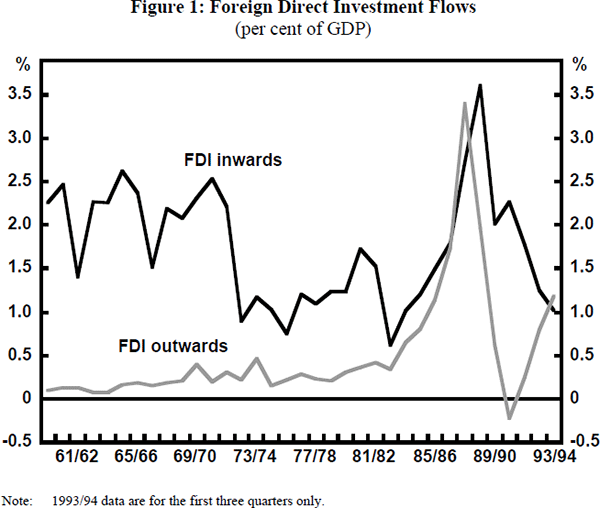
Australia has always been an importer of capital, partly reflecting our rapid population growth and the consequent need to provide social and economic infrastructure. The high level of inwards FDI in the second half of the 1980s was not out of line with that in the 1960s or the early 1970s. But the lift in FDI outwards over the second half of the 1980s – to a high of over 3 per cent of GDP – represents a significant change from historical experience. The recent trends in FDI for Australia correspond to the worldwide expansion in FDI flows, and capital flows more generally, over the same period (see Figure 2).
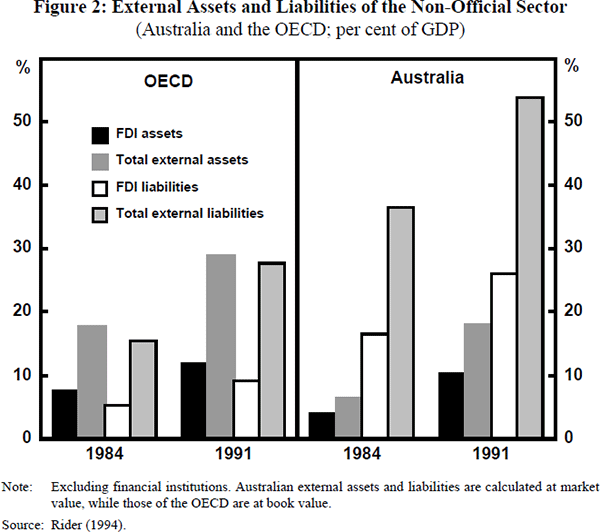
It has been argued, for example by Froot (1991), that the traditional theories of FDI flows that focus on firm-specific and locational advantages (see Appendix A), do not fully explain periodic surges in FDI such as occurred over the second half of the 1980s.
Additional explanations usually focus on the coincidence of several factors. Widening external imbalances among OECD countries would have established the conditions for offshore investment. Figure 2 shows that, for the OECD, changes in FDI played the lessor role in the growth of private sector liabilities, accounting for about one-third of the total change in non-official external liabilities from 1984 to 1991.[2] In contrast, for Australia, non-official FDI liabilities accounted for about 50 per cent of the change in external liabilities over the same period. This reflects a lower share of FDI flows in foreign investment than had been the case in the previous two decades.[3]
Australia's external deficits and our depreciating exchange rate in the 1980s may have contributed to the increases in FDI liabilities in Australia in the 1980s. But these factors fail to explain why Australia increased FDI asset holdings over the period (from about 4 per cent of GDP in 1984 to about 10 per cent of GDP now, a level which is not far below the OECD average).
Financial liberalisation enabled significant outwards FDI flows to occur for the first time in many OECD countries, including Australia. This was particularly important in the case of Japan where, by world standards, liberalisation coincided with a relatively low cost of equity and a very strong currency. These factors made foreign assets relatively cheap to acquire.[4] Such an explanation can be reconciled with traditional FDI theories. For example, acquisitions of foreign firms by Japanese firms would have improved market access in areas where they believed they held competitive advantages. Similarly, Australian investors may have been responding to first-time opportunities to invest offshore, except that in this case the offshore investments were largely financed using overseas borrowing (Bullock, Grenville and Pease 1992).
Rapid technological progress and innovations were also very important. First, innovations in corporate financing and improvements to information technology made it easier, and less risky, to acquire foreign assets through mergers and acquisitions (which increased markedly over the period as a means of conducting FDI). Second, in some cases, technological advances have led to development and production costs that are beyond the financial resources of even the largest firms.[5] This has created incentives for the formation of alliances, and the international rationalisation of production and R&D. Third, a firm that has developed a technological edge may often invest overseas through FDI, rather than trade in the technology (e.g. through licensing), thereby retaining the benefits of the technological edge for a longer period (see Appendix A).
In fact, the widespread moves towards deregulation in the 1980s were probably an inevitable consequence of the telecommunications and computer revolution and the globalisation process itself. Even if they had wanted to maintain tight boundaries around their economies, governments would have found it very difficult to detect, let alone control, many international financial transactions as electronic banking and other innovative financial services and practices became widespread.
Policy changes – including those in the areas of tax, competition policy and microeconomic reform – may also help to explain part of the increased FDI flows in the second half of the 1980s. However, the reverse can also be argued: policy changes may have been driven by the increased mobility of capital (and embodied technology and management skills). If this is the case, it tends to raise the costs of policy failure if investment opportunities are missed.
The role that we are ascribing to technological change here is not universally accepted as an explanator of the surge in FDI in the 1980s. For example, Froot (1991) argues that by lowering transaction costs, technical progress would have reduced the need for firms to extend their boundaries through FDI. On balance, the sort of surge in FDI that was experienced in the second half of the 1980s may never be fully explained by any particular theory of FDI. Nonetheless, the factors that traditional FDI theories would predict as being important clearly played a role. Indeed, Figure 3 shows a relatively close correlation between inwards FDI (relative to GDP), corporate profitability and GDP growth. At the aggregate level this is consistent with the market-based and supply-side determinants of location for FDI that are predicted by the traditional theory (as outlined in Appendix A). Whether the theory helps to explain trends at a more disaggregated level is addressed in Section 3.
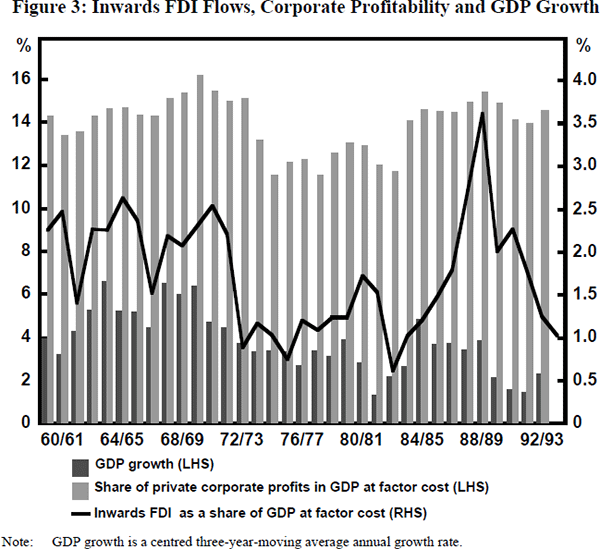
Complementing the technological incentives to openness on the financial side was the reasonably widespread dismantling of trade barriers, as governments became convinced of the benefits of freer trade in goods and services. Figure 4 shows the increase in trade intensity for both Australia and the OECD since the early 1980s. Figure 5 shows the relationship between growth in exports and total-factor productivity (TFP) that has helped to motivate the shift towards greater international integration of OECD countries in recent years.

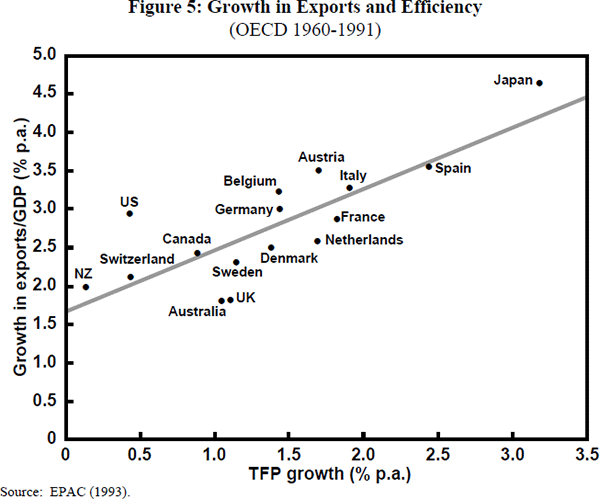
3. Trends in the Structure of Trade and FDI
In this section we examine the recent trends in the structure of trade and FDI, inwards and outwards, with a view to establishing whether they have been consistent with building on competitive advantages that we already have, and/or the perceived requirement to improve competitiveness in the domestic economy.[6] We generally show patterns of FDI and trade together in order to shed some light on whether there is any systematic relationship between the two.
The issue of the effects of FDI on trade and industry structure has been discussed in a number of recent publications, and a summary of the debate is presented in the accompanying box.[7] However, little has been done empirically to address this question. One reason for this is the paucity of data, particularly in respect of FDI by Australian companies overseas. Also, the data that are available are aggregated by industry.[8] These problems are equally pressing here and we are forced to take a qualitative approach to analysing the impact of FDI at a disaggregated level. That said, if there are systematic effects on trade and industry structure associated with FDI flows, the effects should be appearing at the level of aggregation that we examine here.
3.1 Regional Composition of Trade and FDI
Over the past decade, the Asian and East Asian economies have increased in importance as both a market for our exports and as a supplier of our imports (Figure 6). Within this change there has also been a shift in the direction of trade from Japan towards the more rapidly growing East Asian economies. Australia's experience in this regard is similar to that of most developed countries as world attention switched towards the rapidly growing East Asian economies over the period.
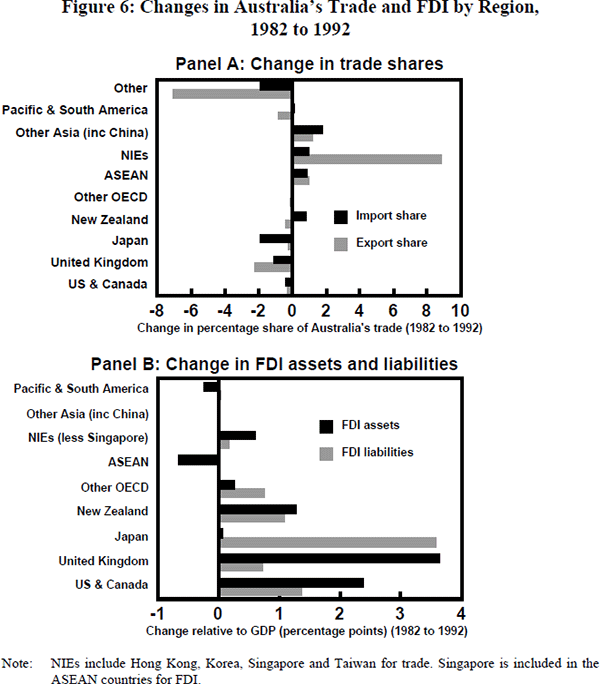
On the other hand, the strong increase in both inwards and outwards FDI over the past decade has been dominated by OECD countries that are our ‘traditional’ trading partners. Japan has accounted for the bulk of changes in inwards FDI but has been well supported by North America, New Zealand, the UK and other OECD countries. Outwards FDI has followed a similar pattern, except in the case of Japan, which generally discourages inwards FDI.
The reliance on OECD countries as a source of FDI is generally explicable in terms of the technological superiority of these countries with respect to production, management and marketing. If FDI is reflecting firm-specific advantages, we would mostly expect to find them in these countries. Also, as noted in Section 2 the coincidence of financial liberalisation, low costs of equity and very strong currencies in Japan and some European countries meant that Australia was bound to increase its sourcing of FDI from these areas. Finally, a number of East Asian economies, including Korea and Taiwan, have discouraged outflows of capital (World Bank 1993).
FDI: Its Links with Trade and Industry Structure
Concerns about the impact of FDI on trade usually centre on whether FDI is complementing potential gains from trade or whether it may be displacing trade, such that the benefits derived from FDI would have been available anyway. One reason for this concern is that FDI is itself trade in factors of production. For example, management expertise, technology and organisational know-how might be traded for access to markets, raw materials or cheaper labour. But this view is based on the notion that international factor and goods markets operate perfectly. In this case, FDI flows would not be necessary. Given imperfect markets, FDI should complement trade in goods and services (Markusen 1983). But, as noted by the East Asia Analytical Unit (EAAU), FDI can, in the short term at least, have trade-displacing or trade-enhancing effects depending on the circumstances involved (EAAU 1994). As is also pointed out by the EAAU, the equilibrium effects will generally counter any short-run effects of FDI on trade.
For example, an FDI project by an Australian company in Asia that generated an enormous increase in the export of Aus-widgets will inevitably displace other potential exporters. The magnitude of this effect would be subject to effects on the exchange rate which, in turn, may ultimately depend on how the additional export income is spent. Transition is important because it may be obvious that eventually resources would have been directed into Aus-widgets, but the FDI would still be beneficial if it enabled the economy to be restructured. The same argument can be made in the case of FDI that displaced exports. In both cases, the Australian economy will benefit if the export enhancing (or displacing) activity generates a better structure for the domestic economy in terms of longer-run growth.
On this basis, the key determinant of whether FDI is good for the economy or not is ultimately determined by its effects on the structure of the economy. The impact on trade is important because it allows us to obtain some insights into whether or not we are getting the right sort of structure. (Although trade-enhancing FDI is clearly consistent with the aim of better integration in world markets.)
In general, we might expect to find a cross-country investment portfolio that reflects the competitive advantages held by the host country in each location. To an extent, this is what we do see. (Australia, for example, has never found difficulty in attracting FDI into areas of mining.) But it is also clear that the location of FDI responds to factors other than underlying competitive advantages, including a raft of government policies. The behaviour of firms involved with FDI flows will also have a bearing on the structural impact of FDI. Border protection in Australia after World War II is an example of a policy-based distortion. Allegations that FDI firms use market power and behave strategically in the interests of the home country is an example of a distortion that would arise from the FDI investors.
To focus on the effects of FDI on trade alone would risk missing the point that the restructuring and globalisation of the Australian economy are ultimately aimed at creating the conditions for longer-term growth and increased wealth, not a better trade performance per se. Stronger growth and improved trade performance are of course inter-linked for the economy as a whole, but not necessarily for each sector, industry, or firm.
Australia was not alone in directing the bulk of its outwards FDI towards OECD markets as worldwide flows of FDI in the 1980s were concentrated in Europe, Japan and the US (UNCTAD 1993). One explanation for the disproportionate amount of outwards FDI flowing to OECD countries is that these economies comprise the vast bulk of the world market. It is logical for companies which perceive themselves to have a competitive edge to take that edge into the large markets first. Another is that investors focussed on culturally-close markets as potential locations in their initial phase of investing offshore (see, for example, Yetton, Davis and Swan (1991)). Also, the EAAU (1994) argues that lack of information about institutional changes (including lower protection) and about growth prospects in Asia may have played an important role in low Australian FDI investment in that region.
Whatever the reason for the lack of FDI flows corresponding to the regional focus of trade in the past decade, it appears that it may be reversed in the future. Access Economics estimate that over 50 per cent of the value of current and planned outwards FDI projects are expected to be located in Asia (including PNG) (Access Economics 1994). About half of these projects are in the mining industry, 10 per cent in manufacturing, and services comprise the rest.
3.2 Composition of Trade and FDI by Industry
At a broad industry level we again observe little correspondence between recent trends in trade and FDI. Figure 7 shows that manufacturing comprises the bulk of our trade whereas services dominate FDI assets and liabilities. The changes over the past decade have emphasised the difference, with manufacturing increasing its share of trade, and the service sector its share of FDI.
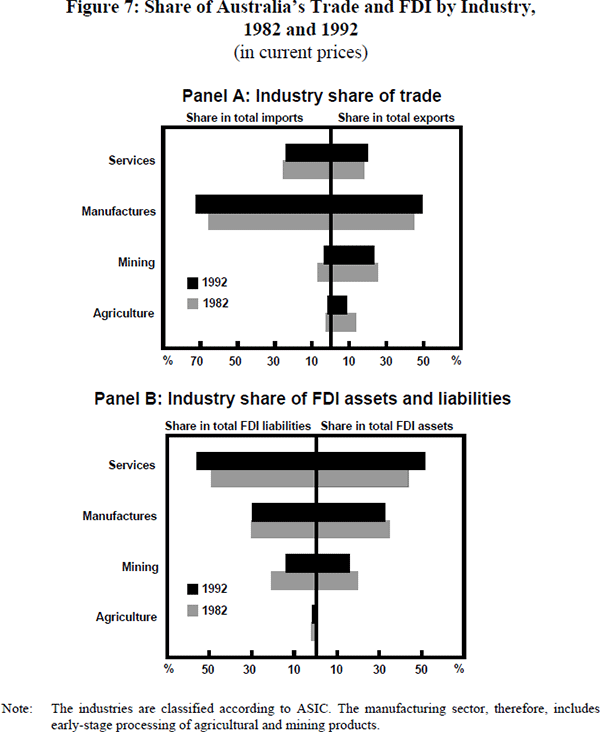
The strong performance of the manufacturing sector in exports over the past decade partly reflects a continuation of the long-run reduction in the terms of trade for commodities (particularly for mining products in the 1980s).[9] But manufacturing exports have also grown more rapidly than agriculture and mining exports in volume terms. At the same time, manufacturing imports have increased as a share of total imports and the trade deficit in manufacturing has not improved by much (BIE 1994). Some may view these results with concern, arguing that a reduction in the manufacturing trade deficit is essential to Australia's economic future. But the real issue is whether or not Australia is making the best possible use of its resources. We should expect a trade deficit in manufacturing in a country that generates surpluses through the export of natural resources. In addition, the correspondence of increases in exports and imports suggests increased specialisation and restructuring within the manufacturing sector, which is consistent with the globalisation process.
The domination of FDI flows by the service sector is a relatively recent phenomenon. In the 1950s and 1960s, manufacturing and mining were more highly represented. This change in the composition of FDI happened almost everywhere reflecting the increased importance of services as a component of national product in most industrial countries (OECD 1992a). Also, the non-tradeable nature of much of the service sector means that firms with competitive advantages in Australia are unable to reap the benefits through trade, but they can through FDI. The increase in the service sector share in the 1980s mainly reflects financial liberalisation and the attendant world-wide increases in FDI in the finance, property and business service sector.
The decline in the relative importance of Australia's manufacturing sector in FDI inflows partly reflects the trend decline in manufacturing production relative to GDP in most developed countries. The BIE (1993a) concluded that it may also be due to changes in Australia's trade policies away from import replacement (and border protection). The removal of trade barriers over the past decade and increased mobility of capital might have been expected to be associated with significant disinvestment in the less competitive manufacturing sector. But the manufacturing sector largely maintained its share of FDI liabilities (and assets), despite the fact that it was a period of enormous growth in both inwards and outwards FDI. The correspondence of increased inwards and outwards FDI in manufacturing is consistent with increased specialisation in production. More importantly, it appears that, the opportunity to disinvest domestically in manufacturing has not been taken up. This probably reflects the substantial supply-side improvements in Australia's manufacturing sector over the decade, as well as reductions in company tax rates and measures to increase international links (such as partnerships for development and the ‘Factor f’ program).
Figure 8 confirms that most of the FDI in service industries has been directed into the non-traded areas of finance, property and business, and wholesale and retail services. This is not to say that investment in these areas cannot contribute to improved trade. Outputs from these industries are often embedded in traded goods and services. Improvements to productivity through technology transfer and organisational innovations in these industries that result from FDI can play an important role improving competitiveness more generally.
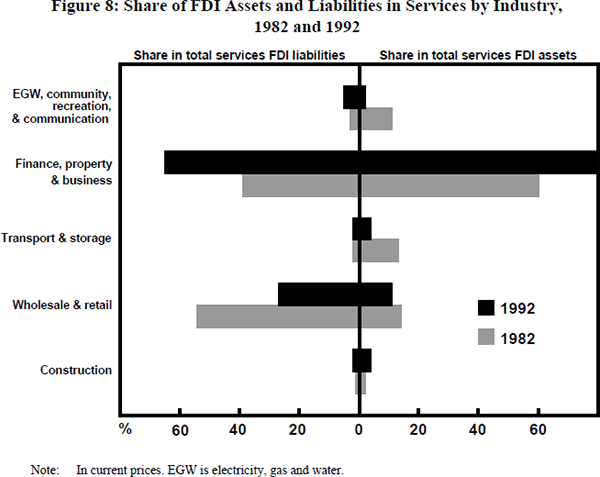
There is little doubt that FDI in the wholesale and retail sector has generally improved efficiency in Australia. The experience in finance, property and business has been more mixed. Much of the FDI flows into this sector in the 1980s were responding to – and helped to fuel – the asset price boom in property. Foreign (and domestic) investors have experienced substantial losses in the subsequent fallout. Similarly, some of the Australian investments offshore in this sector have not performed well. Transmission of the asset price boom was a major source of instability in the Australian (and world) economy over the past decade. However, any deleterious effects, including those on industry structure, are likely to be unwound through the restructuring of corporate balance sheets and investment portfolios.
The fact that over 50 per cent of FDI assets and liabilities are accounted for by low-trade service industries is an important counter to those who argue that we should be concerned about trade displacement of FDI. Much of the increase of trade in services has been accounted for by tourism, but the FDI in this sector (included in EGW etc. in Figure 8) has not been a significant portion of total FDI in services. Also, if we are concerned about FDI flows distorting domestic production towards low-value-added activity, we would generally not look to the service industries for evidence. These industries tend to have higher wages than manufacturing and agriculture. Agriculture attracts very little FDI flows (Figure 7). It follows that if we are to get an appreciation of the impact of FDI on trade and industry structure we need to focus attention on the manufacturing sector.
In order to examine the impact of FDI flows on the structure of the domestic manufacturing industry we need to get some idea of where Australia's competitive strengths lie, and where changes in competitiveness have occurred. One way to do this is by measuring revealed comparative advantage by industry in the manufacturing sector.[10]
The OECD (1993) calculated a set of revealed comparative advantages (RCAs) for manufacturing industries in a sample of 13 OECD countries. As defined by the OECD, an industry's RCA is its share in the country's exports as a ratio of the average share in exports of that industry for all the countries in the sample. The set of OECD RCAs show the export orientation for a country, by industry, relative to the wider OECD area. If an industry's RCA is greater than unity, then that industry's export orientation exceeds the OECD average. This is interpreted as reflecting a relative (revealed) advantage held by that industry in international trade.
The BIE has also been monitoring the relative trade orientation of industries in Australia's manufacturing sector using estimates of export propensity and import penetration (BIE 1993b, 1993c). It is possible to draw comparisons with the OECD estimates of RCAs for Australia's manufacturing industries using the BIE estimates of trade orientation. One measure involves scaling the BIE measures of trade orientation for each industry by the trade orientation of the manufacturing sector as a whole. A second method is to scale the exports to imports ratio of each industry with the ratio of exports to imports of the total manufacturing sector. Figure 9 compares results using these methods with those generated by the OECD for a comparable sample of manufacturing industries. It is clear from the figure that the alternative approaches yield similar results across most industries. There is some difference in the relative magnitudes of RCAs, particularly for Basic Metal Products. Nonetheless, the same conclusions about comparative advantage within the Australian manufacturing sector would be drawn using any of the three measures shown.
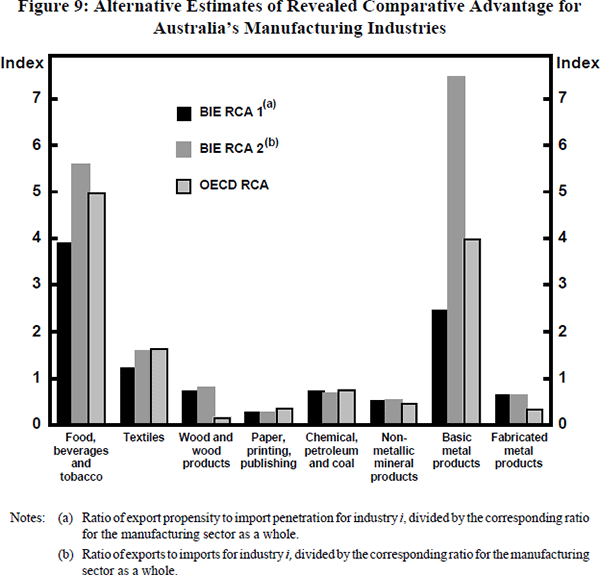
The similarity of results should not be surprising because, in all three methods, the results are driven by the relative export performance of the industry concerned. The results, however, are an important platform for the discussion of trends in foreign direct investment by the manufacturing sector.
Matching up changes in FDI flows with measures of revealed comparative advantage enables us to address two important questions related to the impact of FDI on the structure of the manufacturing industry. First, what is the relationship between an industry's comparative advantage in trade and its involvement in FDI? Second, what is the relationship between FDI flows and changes in Australia's revealed competitive strengths? These issues are addressed in subsequent sections of the paper.
3.3 FDI Orientation and the Structure of the Manufacturing Industry
Figure 10 shows the relationship between an industry's competitiveness in 1982 and subsequent changes in its FDI orientation. The horizontal axis shows the RCA for each industry. Industries with a high RCA are located to the right of the mid-point of this axis, and low-RCA industries to the left. The figure shows that in 1982, the Food, Beverages and Tobacco, and Basic Metal Products industries had the highest RCA's. These industries generate large surpluses by adding value to primary products and (following the methodology established by the BIE (1993b)) can be classified as the ‘export group’ of Australian manufacturing industries. Moving left along the horizontal axis, another grouping can be characterised as the ‘intra-industry trade’ group. To a degree, intra-industry trade is a feature of all twelve manufacturing industries. However, it is most apparent in Textiles, and Chemicals, Petroleum and Coal products industries.[11]
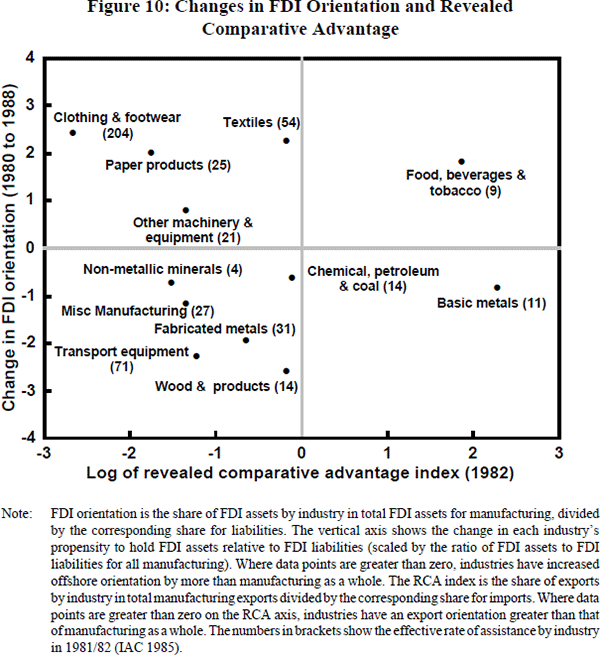
A third group of industries can be characterised as being ‘low-trade’ as they have both low import penetration and export propensity, due to a high level of natural protection from import competition (BIE 1993b). These industries include Fabricated Metal Products, Non-Metallic Mineral Products, and Wood and Wood Products. They are primarily geared towards the domestic market and are generally competitive in that market.
The final set of industries, including Clothing and Footwear, Transport and Equipment, Other Machinery and Equipment, Miscellaneous Manufacturing, and Paper and Paper Products suggest themselves as primarily import industries. This group has been generally characterised as being internationally uncompetitive through cost disadvantages, particularly in the early 1980s.
The vertical axis of Figure 10 shows the changes in orientation of FDI in the 1980s by industry while holding the index of comparative advantage fixed in 1982.[12]
The low-trade group, Chemicals, Petroleum and Coal (an intra-industry group) and two import-group industries (Transport Equipment and Miscellaneous Manufacturing) increased relative holdings of FDI liabilities from 1980 to 1988.[13] F or the latter, this may be somewhat surprising given the reduction in border protection over the period (and promises of continued reduction into the 1990s). The inwards FDI in these industries is therefore probably unrelated to prospects of border protection. It is much more likely to be due to the fact that these industries are focussed primarily on the Australian market and to microeconomic reforms that have improved profitability in these industries over the past decade. Government policies aimed at enhancing links with foreign investors such as Partnerships for Development, and the ‘Factor f’ program for pharmaceuticals may also have helped to attract inwards FDI.
The propensity to move offshore from 1980 to 1988 was most apparent in less competitive industries (Clothing and Footwear, Paper and Paper Products, and Other Machinery and Equipment). Textiles, which is allocated here to the ‘intra-industry trade’ group, also suffers from severe cost disadvantages in certain areas, and has been highly protected in the past. There is little doubt that moves offshore in these industries reflect the cost disadvantages of locating certain stages of manufacturing in Australia.[14] For example, according to the Textiles Clothing and Footwear Development Authority (TCFDA 1993), much of the investment offshore in clothing and footwear has been directed to China in the area of low-value-added clothing manufactures (where labour costs are estimated to be 4 per cent of those in Australia).
However, the industry has been able to retain some competitive elements within Australia. The domestic industry has restructured to focus more on low-volume production, incorporating greater design content, higher quality, and higher prices (TCFDA 1993). Restructuring under these circumstances may well have enabled Australia to hold onto these competitive areas of the industry. Furthermore, it may help to generate competitive advantages in design and marketing in future, as these aspects of the industry will not be weighed down by high relative costs in lower value-adding stages of production.
That said, there are likely to be substantial costs associated with adjustment for people who find themselves out of work because of measures to improve productivity and relocate production. The government has provided assistance for industries in transition in order to lower the costs of adjustment and enhance restructuring of domestic production towards more competitive parts of the industry. Specific measures include assistance with lowering the costs of upgrading capital stock, and more recently through the Import Credit Scheme which offers duty credits on exports, and the Overseas Assembly Scheme which provides preferential treatment of Australian fabrics assembled overseas.
The experience of the Food, Beverages and Tobacco industry over the 1980s is more problematical. In some cases, the offshore investment, for example by major beverage producers in Europe and North America, has been clearly market driven. In other cases, there has been cost-based restructuring of this industry along similar lines to that of clothing and footwear. This process has, however, been helped along by Asian governments offering investment incentives for agri-food producers to move operations to Asia. How important these enticements have been is difficult to assess but two factors are worth considering.
First, the offshore FDI in these industries may have occurred at any event. The Asian market is extremely large and fast growing which would be a strong incentive for entry by Australian producers of food and beverages. Marketing success in these industries is often associated with intangibles such as trademarks, strong cultural identification with the product, and leading-edge packaging and promotions. Competitive advantages associated with production may not always be readily transferable to marketing and distribution, as there may be significant imposts on the traded product arising from transport costs, duties and interest cost of capital tied to goods in transit.[15] The nature of the products suggests that much of the offshore FDI in the 1980s may have come about through a legitimate desire to capture additional markets based on competitive strengths developed in Australia.
Second, there has been quite strong FDI investment in Australia in the Food, Beverages and Tobacco industry reflecting, among other things, Australia's competitive advantage in agriculture, and location advantages in infrastructure and close proximity to the large Asian market (BIE 1994). More recently, there have been reports of strong Japanese investment in Australia in the food industry.[16] In fact, in 1992, the Food, Beverages and Tobacco industry had a lower propensity to invest offshore compared with manufacturing as a whole (although this change may be related to the economic downturn).
On balance, it seems unlikely that the increased orientation towards offshore FDI by the Food, Beverages and Tobacco industry would have negative effects on the structure of the domestic industry. Indeed, overseas investment in this industry probably enhances intra-industry trade and creates jobs in higher value-added areas (such as management and technical services), as firms strive to maintain competitive advantages. It is true that there is a risk that overseas operations may develop to such an extent that we eventually become relatively less competitive in these areas. However, that would imply more rapid innovation, greater efficiency, and improved products on the part of the offshore operations. In such circumstances, rather than increased imports, we would likely see more FDI inwards in Australia and the catch-up process would be reversed.
Finally, it is worth noting that many manufacturing industries in Australia increased FDI liabilities, as well as FDI assets, in the 1980s (see Figure 11). This, of itself, is indicative of restructuring within industries. The net effect may be very small in terms of changes in the FDI orientation measure used here, but the implied restructuring can have strong positive effects for the industries concerned. Also, while the discussion here has focussed on the shift offshore following financial liberalisation, it is worth noting that FDI assets were still only about 50 per cent of FDI liabilities in manufacturing in 1992 (up from 25 per cent in 1980). The continued flow of inwards FDI to Australian manufacturing by itself suggests that the industry has significant marketing and production advantages for foreign investors.
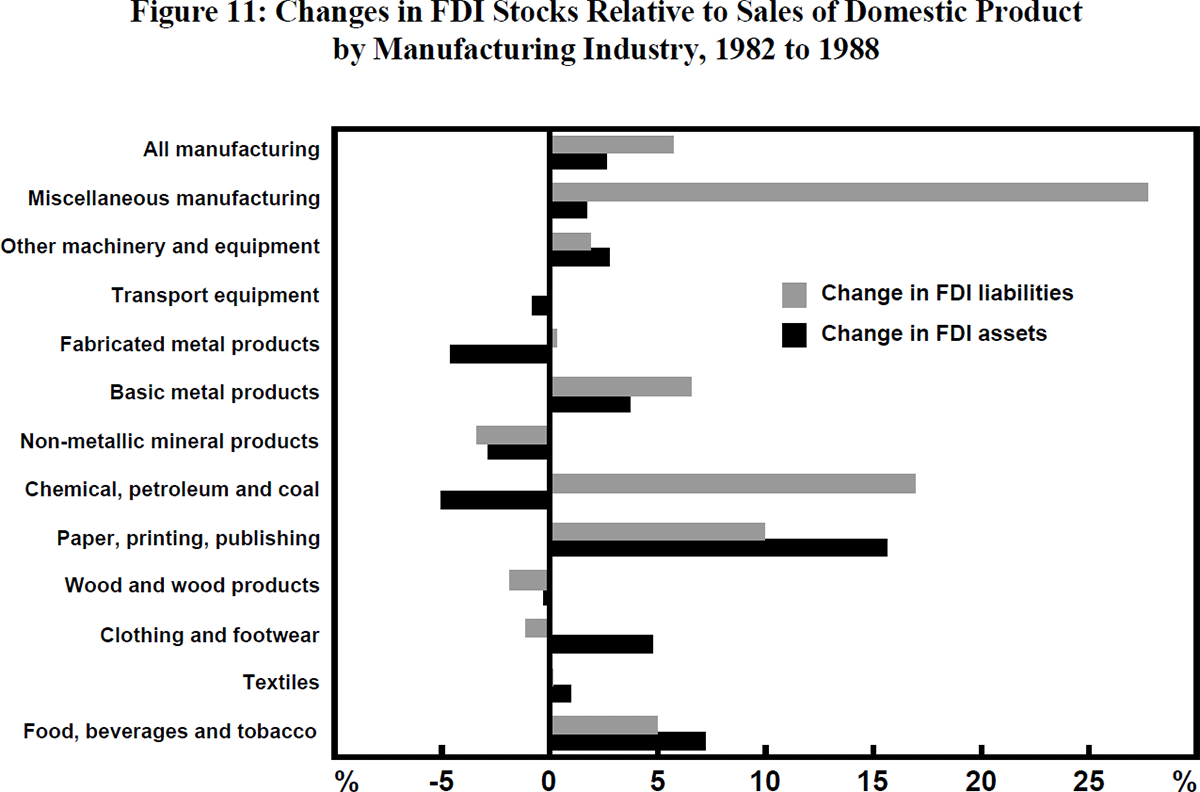
3.4 Changes in FDI Orientation and Trade Performance by Industry
Apart from effects on industry structure, one concern about large changes in FDI flows is the impact on trade. This section examines the association between changes in FDI orientation from 1980 to 1988 and changes in manufacturing trade by industry over the past decade or so.
Figure 12 shows the change in orientation of FDI over the period 1980 to 1988, alongside changes in the share of manufactured exports by industry from 1982 to 1992. If an industry has increased its propensity to hold FDI assets relative to liabilities (compared to the average for manufacturing as a whole) it will be in the positive half of the vertical axis. Industries that increased their relative share in exports will be in the positive half of the horizontal axis.
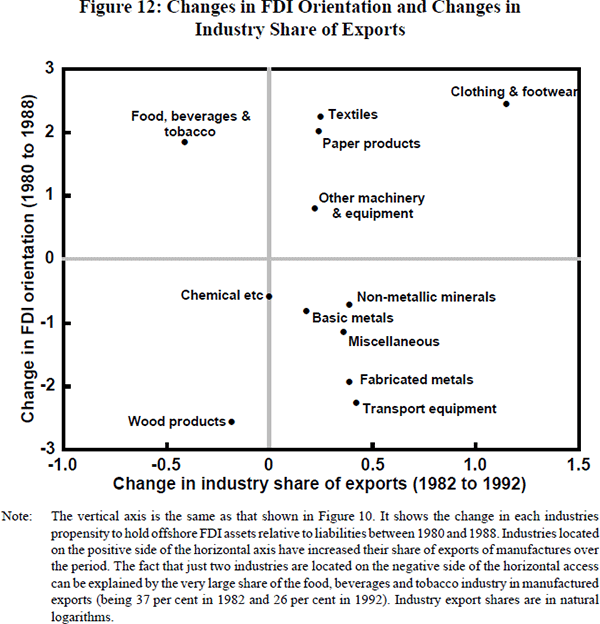
The data shown in Figure 12 suggest that the change in outwards orientation of FDI does not appear to be systematically associated with changes in export shares. In some industries (notably Clothing and Footwear) a shift towards holding more offshore assets corresponds with very strong growth in exports. As noted earlier, both the Textiles and Clothing and Footwear industries shifted less competitive later-stage processing plants offshore over the period. This meant increased intra-industry trade as Australian firms increased the export of early-stage products to offshore plants. The consequent growth in imports of the more highly processed products is particularly apparent for clothing and footwear products (Figure 13).
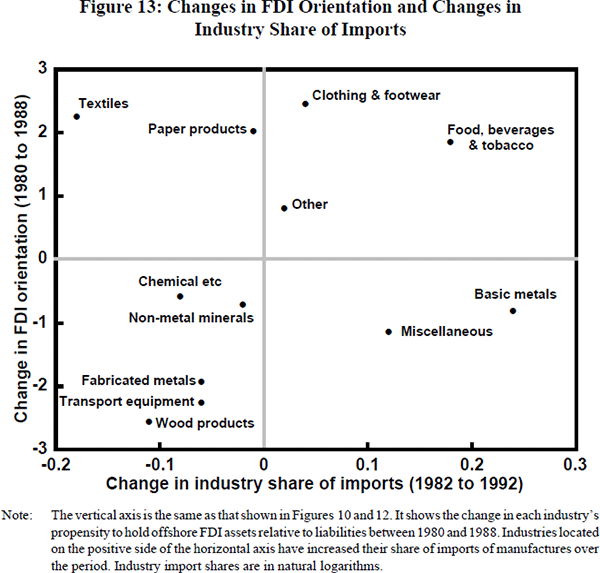
In fact, if there is any systematic relationship between FDI flows and trade it may lie in a positive correlation between the change in the volume of trade and total FDI (Figure 14). The figure suggests a very tenuous degree of complementarity between the two variables. More definitive results might emerge if comparisons could be made over a longer period of time, but the necessary data are not available.

Exports by industries that increased holdings of FDI liabilities also rose quite dramatically over the period (Figure 12). Much of this increase represents greater product differentiation and specialisation in these industries. Not surprisingly, these industries did not increase imports to the same extent as those industries which tended to shift production offshore (Figure 13).
The stand-out industry in Figures 12 and 13 is the Food, Beverages and Tobacco industry which increased its outwards FDI orientation significantly from 1980 to 1988 and experienced sluggish growth in exports, and a more rapid growth in imports, relative to other industries. There may be a suggestion that the shift in FDI orientation has been harmful for this industry.
On the imports side it is probable that Australia's demand for imported (highly differentiated) food and beverages reflects changes in the structure of our population and greater competition from Asian producers, along with the well-known effects of EC agricultural subsidies.
On the exports side we need to place the relatively poor performance of Food, Beverages and Tobacco over the past decade in the context of the very strong performance of all other manufacturing industries over the period. Table 1 shows the growth in manufactured exports for manufacturing industries at the 2-digit ASIC level between 1982 and 1992, classified according to the trade groups used in this paper. It is true that exports by the Food, Beverages and Tobacco industry grew slower than average over the past decade. But nominal growth of exports from food, beverages and tobacco manufacturers was still a very respectable 8.4 per cent per year between 1982 and 1992, which was only marginally below nominal GDP growth. In fact, exports of food, beverages and tobacco products grew much more quickly than did exports of the agricultural products from which they are made (see Table 2). Moreover, since world demand for early stage manufactured foodstuffs is probably linked quite closely to the demand for primary produce (EPAC 1988), the slow growth in agricultural exports may suggest a primary reason for the relative decline in exports of food, beverage and tobacco manufactures.
| Value 1982 ($m) | Value 1992 ($m) | Average annual growth 1982 to 1992 (per cent) | Contribution to total export growth 1982 to 1992 (percentage points) | |
|---|---|---|---|---|
| Total | 10,290.3 | 33,377.6 | 12.5 | 100.0 |
| Export group | 6,804.4 | 20,366.1 | 11.6 | 58.7 |
| Food, beverages and tobacco | 3,795.1 | 8,540.9 | 8.4 | 20.6 |
| Basic metal products | 3,009.3 | 11,825.2 | 14.7 | 38.2 |
| Import group | 1,292.9 | 6,156.5 | 16.9 | 21.1 |
| Clothing and footwear | 15.8 | 182.9 | 28.2 | 0.7 |
| Transport equipment | 324.2 | 1,672.9 | 17.8 | 5.8 |
| Other machinery and equipment | 680.1 | 3,005.1 | 16.0 | 10.1 |
| Miscellaneous manufactures | 185.8 | 905.9 | 17.2 | 3.1 |
| Paper, printing and publishing | 87.5 | 389.6 | 16.1 | 1.3 |
| Intra-industry trade group | 1,791.5 | 5,350.2 | 11.6 | 15.4 |
| Textiles | 580.7 | 2,302.1 | 14.8 | 7.5 |
| Chemical, petroleum and coal products | 1,210.7 | 3,048.1 | 9.7 | 8.0 |
| Low-trade group | 401.5 | 1,504.8 | 14.1 | 4.8 |
| Non-metallic mineral products | 44.7 | 252.5 | 18.9 | 0.9 |
| Fabricated metal products | 148.5 | 734.3 | 17.3 | 2.5 |
| Wood, wood products and furniture | 208.3 | 518.0 | 9.5 | 1.3 |
| Memo: GDP ($m) | 167,916 | 396,250 | 9.0 | n.a. |
|
Source: DFAT Stars database. |
||||
| Value 1992 ($b) | Average annual growth 1982 to 1992 (per cent) | Contribution to total export growth 1982 to 1992 (percentage points) |
|
|---|---|---|---|
| Total | 54.4 | 10.6 | 100.0 |
| Agriculture | 5.7 | 2.8 | 3.9 |
| Mining | 15.4 | 11.3 | 29.2 |
| Manufacturing | 33.4 | 12.5 | 66.8 |
|
Source: DFAT Stars database. |
|||
Virtually every other manufacturing industry experienced export growth well in excess of GDP growth over the period 1982 to 1992. Perhaps the most notable feature being the rapid export growth from those industries that started from a position of being least competitive – the ‘import group’ (Table 1). The impressive export performance of the import-group industries over the past decade is encouraging as it suggests Australia is able to successfully compete in niche markets for more highly value-added products.[17] It is consistent with the findings of the recent Emerging Exporters study (McKinsey and Co. 1993).[18] In fact, the results may even indicate a wider export success for niche marketing of import group industries than that suggested by McKinsey and Co. (1993), which focussed on the performance of selected firms from all manufacturing industries.
On balance, therefore, the decline in share of food, beverage and tobacco exports does not appear to be due to an increased propensity for investment offshore. It is more likely to be a consequence of shifts in world demand and the very strong export performance by other manufacturing industries.
Another encouraging aspect of the performance of Australia's manufacturing exports from 1982 to 1992 is the very strong growth in exports to Asia (see Table 3). The growth rate of exports in all manufacturing industries (with the exception of miscellaneous manufactures) from 1982 to 1992 was greater for Asia (Table 3) than for all regions combined (Table 1). In particular, exports of basic metal products to Asia grew strongly (at an average rate of 29 per cent per annum) as Australia's comparative advantage in early-stage processing of metals matches well with demand from rapidly growing Asian producers of more elaborately transformed metal based manufactures. Concerns have been raised about the declining share of aggregate exports in East Asian imports, the suggestion being that Australia may be losing competitiveness (IC 1993). Figure 15, however, shows that manufacturing sector exports have increased penetration in most markets over the period 1985 to 1991, including in most East Asian markets. At the same time, however, the share of Australia's total exports in East Asian imports fell from a little over 4 per cent to about 3.7 per cent (IC 1993).
| Value 1982 ($m) | Value 1992 ($m) | Average annual growth 1982 to 1992 (per cent) |
Contribution to total export growth to Asia 1982 to 1992 (percentage points) |
|
|---|---|---|---|---|
| Total | 3,667.3 | 17,706.7 | 17.1 | 100.0 |
| Export group | 2,280.9 | 11,568.7 | 17.6 | 66.2 |
| Food, beverages and tobacco | 1,707.6 | 4,016.7 | 8.9 | 16.4 |
| Basic metal products | 573.3 | 7,552.0 | 29.4 | 49.7 |
| Import group | 358.8 | 2,285.9 | 20.3 | 13.7 |
| Clothing and footwear | 3.7 | 27.8 | 22.2 | 0.2 |
| Transport equipment | 35.1 | 400.0 | 27.5 | 2.6 |
| Other machinery and equipment | 214.7 | 1,370.9 | 20.4 | 8.2 |
| Miscellaneous manufactures | 82.1 | 351.5 | 15.6 | 1.9 |
| Paper, printing and publishing | 23.1 | 135.8 | 19.4 | 0.8 |
| Intra-industry trade group | 783.1 | 2,887.4 | 13.9 | 15.0 |
| Textiles | 430.5 | 1,737.2 | 15.0 | 9.3 |
| Chemical, petroleum and coal products | 352.6 | 1,152.2 | 12.6 | 5.7 |
| Low-trade group | 244.5 | 964.6 | 14.7 | 5.1 |
| Non-metallic mineral products | 14.4 | 141.0 | 25.7 | 0.9 |
| Fabricated metal products | 50.9 | 364.6 | 21.8 | 2.2 |
| Wood, wood products and furniture | 179.3 | 459.0 | 9.9 | 2.0 |
|
Source: DFAT Stars database. |
||||

In summary, the export performance of the manufacturing sector appears to be compatible with perceived requirements for increased integration with world markets, in particular the Asian region. Moreover, the data (at the 2-digit ASIC level) suggest that FDI flows have been generally consistent with assisting the adjustment process necessary for a better trade performance. The lack of FDI investment in Asia (relative to total FDI assets) may have meant slower growth of exports to Asia than would otherwise be the case (IC 1993). However, the growth in exports to Asia has been impressive and with FDI outflows from Australia's manufacturing sector to Asia set to increase (see Access Economics (1994)), this constraint is likely to become less important.
That said, the very strong performance of some of the less competitive ‘import group’ industries is partly due to government assistance with restructuring aimed at lowering costs, promoting exports, and improving links with multinational companies. A more complete assessment of the underlying strength in these industries awaits the unwinding of restructuring assistance measures.
Finally, it needs to be remembered that manufacturing sector imports also grew very strongly over the past decade, and imports exceeded exports by more than $28 billion in 1992. The fact that imports exceed exports in manufacturing is not surprising. The generation of strong export growth relies on Australia's ability to produce specialised goods for niche markets. This takes time and involves increased imports as intra-industry trade expands.
3.5 Intra-Industry Trade
Throughout the discussion of recent trends in Australia's trade and FDI, mention has been made of signs that intra-industry trade has increased over the past decade. A sustained increase in the level of intra-industry trade signals increased specialisation and concentration on niche production/marketing within the industry. This is consistent with increased globalisation. It is also beneficial in the adjustment process for Australia's historically less competitive areas of manufacturing. To the extent that these industries can adapt and forge competitive strengths in specialised areas, the lower will be the costs to the economy in aggregate.
Figure 16 shows that intra-industry trade has increased significantly over the past decade in the import group and in the low-traded group of industries. The index is at a very broad level; lower levels of intra-industry trade would be expected in a more disaggregated study. Also it should be noted that, while a sustained increase in intra-industry trade is indicative of increased integration in international markets, it should not be taken as an indicator of competitiveness. For example, the index of intra-industry trade for the export group has remained quite flat, but competitiveness in these industries may have increased by as much, or more than, in the other industries shown. The export-group industries have historically engaged in inter-industry trade with high exports and low import penetration of the domestic market. For these industries the intra-industry trade index is unlikely to increase unless there is a significant increase in imports. Also, the increased intra-industry trade in the import group of industries mainly reflects the strong export growth over the past decade. The export performance in some of those industries may be due mainly to restructuring assistance measures. The rapid increase in exports and intra-industry trade may plateau with the winding down of these measures.
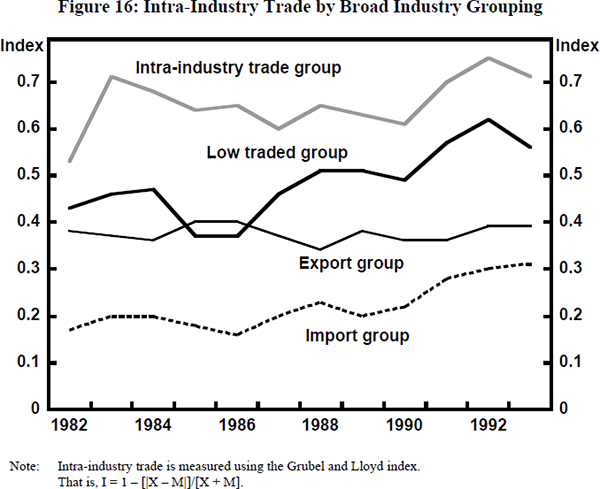
4. Some Issues Arising from FDI Flows
The data presented in Sections 2 and 3 confirm that a feature of the process of internationalisation or globalisation in Australia is increased foreign direct investment and trade. Also, the cyclical nature of FDI suggests that FDI, both outwards and inwards, may be set to increase once recovery becomes more widespread. For example, on the outwards FDI side, Access Economics (1994) has estimated that as of March 1994, about 25 per cent of the value of projects to which Australian companies are committed (or are considering) would be directed offshore, compared with a figure of about 10 per cent just one year ago.
Greater caution following the debt overhang in the 1980s may see increased flows of inwards FDI (equity) in the 1990s (Whitelaw and Howe 1992). In addition, the importance of profitability in attracting FDI (Figure 3) and the current high levels of profitability, along with our geographical and trade links with the fast-growing Asian economies may help to attract FDI into Australia.
In theory, FDI can generate ‘win-win’ benefits similar to those generated through trade. FDI inwards can contribute to investment, import spillover benefits, increase competition domestically, and provide access to world markets. FDI outwards can generate high returns for domestic investors, export management expertise and know-how, enable the purchase of foreign technologies, and expand the market for internationally competitive domestic firms. Yet, the benefits of FDI are sometimes qualified.
Not everyone will welcome high levels of FDI flows. Setting aside ‘cultural’ arguments, typical concerns about FDI inflows in this context include: the potential to bias domestic production towards relatively low-value-added or low-growth industries; concerns about excessive market power of multinational enterprises (MNEs) (especially in certain industries such as the media); and beliefs that MNEs contribute to current account deficits, both through policies that are biased against net exporting and through undesirable capital inflows (that subsequently drive current account deficits, through servicing requirements).[19] It is also argued that outwards FDI can have negative effects on the structure of the domestic economy. In addition, there is a concern that outwards FDI may reduce domestic investment, exports and employment opportunities.[20]
The consensus among economists, however, is that such problems are either illusory, overstated or should be addressed directly rather than intervening in capital markets (and risking the loss of benefits associated with FDI, among other things).
4.1 FDI Flows and Industry Structure
It has been argued that FDI inwards can bias domestic production by displacing investment in strategic domestic activities such as research and development. Testing this hypothesis is beyond the scope of this paper. However, it should be noted that if something untoward were happening in this area, it would be likely to have implications for the conduct of domestic industry policy, rather than for capital market arrangements.
Another example of distortionary behaviour by FDI investors is alleged discriminatory commercial policies that distort domestic production (for example, procurement that is biased towards imports from the home market and export franchises). It is by no means clear that there are problems here. For example, the sourcing of inputs from the home country may be based on sound commercial considerations because home suppliers hold advantages (technological or otherwise) needed by the affiliate. Also, such advantages may diminish over time as suggested by MITI (1992). In fact, this issue may be more critical for Japanese FDI into the US than for Australia. Drysdale (1993) presents evidence to suggest that, in 1990, Japanese affiliates in Australia exported a greater percentage of total sales back to Japan than for investments in North America and Europe, while maintaining a fairly average ratio of imports in total purchases.
In addition, the discussion in Section 3 suggested that recent trends in the direction and composition of Australia's manufacturing trade have been consistent with perceived needs to create a more externally-oriented industry, focussing on production and export of more highly differentiated products for niche markets. Exports from industries based on adding value to mining resources have also grown strongly over the period, whereas exports of manufactures based on agricultural products have been relatively subdued. FDI flows, both inwards and outwards, appear to have been consistent with the industry restructuring needed to underpin a better trade performance.
Problems with multinational enterprises exercising market power also reflect more on domestic competition policies than on the behaviour of MNEs. In fact, there is a widely held view that industry concentration is not a problem as long as new firms can enter relatively easily. Unrestricted threat of entry by foreign investors may therefore be positive for domestic competition. Also, foreign investors can increase domestic competition through the use of new technology and management/workplace practices. Competition among potential suppliers to the foreign company may also be enhanced.
Concerns about alleged abuse of market power and strategic behaviour favouring the home market by FDI investors will remain. However, the analysis in this paper suggests that if there are problems in this area, they do not appear to have been very systematic, or the effects are so small as to have little or no impact at more aggregate levels. The likely answer is that abuses of market power by FDI investors proceed along similar lines as abuses by domestic investors – that is, on a case by case basis. It is worth noting that in the presence of factor-market imperfections, any investment (by domestic or foreign investors) is capable of distorting industry structure and trade.[21] The practical solution is to improve the operation of the appropriate market, through industry or competition policy. Should there be a specific instance of distortion-creating behaviour by FDI investors (in or out) there would probably be little or no implication for aggregate policy governing FDI flows.
4.2 FDI and the Current Account
Arguments that foreign companies influence the current account (in any direction) ignore the fact that current account deficits arise through domestic saving being less than investment, both of which are thought to be driven by more fundamental factors than the structure of external finance. On this view, to the extent that there are any effects of MNE intervention in trade flows, they would eventually be unwound by changes in the real exchange rate.[22] Also, inwards FDI appears to respond to fundamentals governing Australia's investment climate (including growth and profitability), rather than to changes in the aggregate financing requirement. Attempts to address the current account deficit through intervention in FDI flows would involve a high risk that adjustment may come about at a substantial cost to growth (through lower investment).
A coincident increase in both FDI inwards and outwards, such as we saw in the 1980s, may see a continuation of the dominant role for what is often regarded as more ‘footloose’ portfolio and other capital in financing the current account deficit. Figure 17 shows that the increase in outwards FDI meant that in net terms, FDI flows were very low in the 1980s. There is a suggestion that portfolio and other inflows helped to finance offshore FDI investment (Bullock, Grenville and Pease 1992).
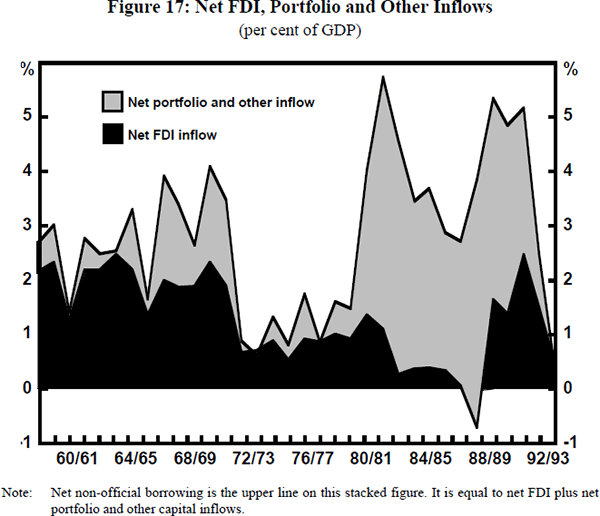
If this happened again in the 1990s, net external debt would probably continue to grow in importance relative to equity in net external liabilities. Although this may help to alleviate concerns about ‘selling off the farm’, it may create renewed concern about exposure of the domestic economy to external shocks, and the costs of adjustment associated with increasing external debt.
On the basis of research by Kearney (1992) and Carmichael (1992), EPAC (1992) concluded that increased capital mobility has not been a source of greater macroeconomic instability, although the view is not universal (Schubert 1992). The potentially adverse consequences of capital market failures continue to be of concern to policy makers, although there is general recognition that there is little to be gained through direct government intervention in capital markets. To the extent that increasing external debt (or portfolio equity) creates problems, it reflects inadequate domestic saving rather than inappropriate external financial structures. Debate about a role for government in influencing the level of foreign debt rightly focus on its role in promoting domestic saving. See FitzGerald (1993), Whitelaw and Howe (1992) and Collins (in this Volume) for a discussion of these issues.
4.3 FDI Outflows and Domestic Investment
It is sometimes argued that outwards FDI may reduce domestic investment, exports and employment opportunities. For example, using a cross-country study of OECD countries, Feldstein (1994a) estimated that each $1 of outward FDI from the US reduces the domestic capital stock by about 20 to 40 cents. The implication is that export potential is shifted offshore. This view relies on the existence of impediments to international capital flows which mean that expansion of domestic capital stock is reliant on domestic saving.[23]
The notion that outwards FDI causes permanently higher unemployment requires domestic labour-market rigidities which impede adjustment to full employment (following any dislocation of jobs directly related to the offshore investment). Although correction of these rigidities may involve some short-term pain, their existence means that there would be high welfare costs associated with any economic shock – and policy should address them directly. Governments can help with the adjustment through programs aimed at reducing costs for the employees concerned, but impeding the flow of FDI offshore is likely to be counter-productive.
However, if outwards FDI lowers domestic investment (as claimed by Feldstein) it could lead to lower capital per worker domestically, reduced productivity growth and lower real wages. There are several points that mitigate such concerns.
First, there may be differing impacts of outwards FDI on a large country that is a world leader in many production technologies (such as the US) compared with smaller, more open, countries that import technology, like Australia.
Second, country-specific studies have generally found that there is no reduction in the aggregate capital stock due to outwards FDI. Blomstrom and Kokka (1994), in a literature review of the issue for Sweden found that outwards FDI in that country stimulated domestic exports and investment. The result is based on the view that the subsidiary captures a greater market share than otherwise possible, and the exports of finished products that are displaced are offset by Swedish exports of intermediate goods and related products. Lipsey and Weiss (1981) and Lipsey (1994) have drawn similar conclusions based on US data.
Although data constraints have not enabled econometric studies of the effects of outwards FDI on exports and capital stock in Australia, most reports that have addressed the issue suggest that we should not be too concerned about possible negative impacts. The BIE (1984), Yetton et al. (1991), McKinsey and Co. (1993), and Edwards (1994) all concluded that outwards FDI was in net terms complementary to Australian exports. Thomsen and Nicholaides (1991) drew the same conclusion for Japanese outwards FDI. The OECD (1992b) suggests that for Japan a 1 per cent increase in the stock of outward FDI is associated with a 0.65 per cent increase in private capital stock in the domestic market.
Third, there are data which do not appear to support the notion that outwards FDI is systematically harmful for export growth, or for growth in capital stock per worker. Figure 18 suggests that changes in the trend rate of growth in exports between 1970–1984 and 1984–1991 across a sample of OECD countries is not strongly correlated with the change in holdings of FDI assets over the same periods.
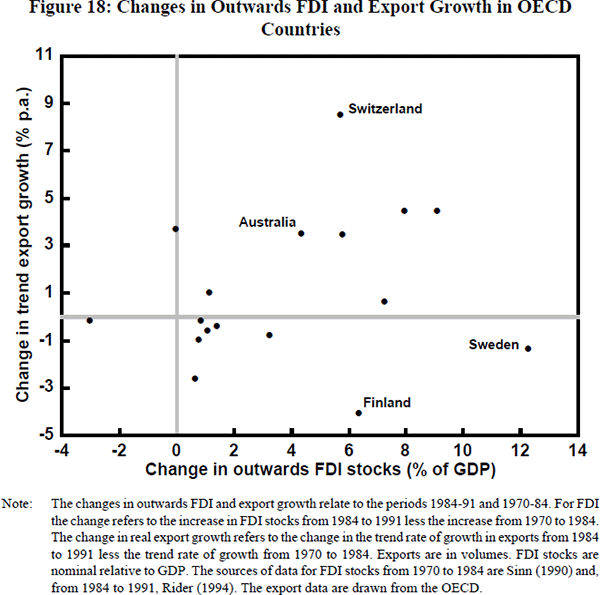
Figure 19 suggests that those countries which increased FDI outwards the most after 1984 tended to experience a lower trend reduction in capital deepening in the business sector than on average.[24] This implies that rather than reducing capital per worker, outwards FDI may help to increase it. One explanation is that outwards FDI from OECD countries may be biased towards labour-intensive industries such that domestic capital intensity is increased by the outflow. An example of this in Australia is the shift offshore of parts of the clothing and footwear industry – which has hardly made a strong contribution to exports. If this is the case, it is consistent with the finding elsewhere in this Volume (see Fahrer and Pease) that pursuit of productivity improvements have been the important factor in reducing employment opportunities for relatively unskilled workers in the 1980s.
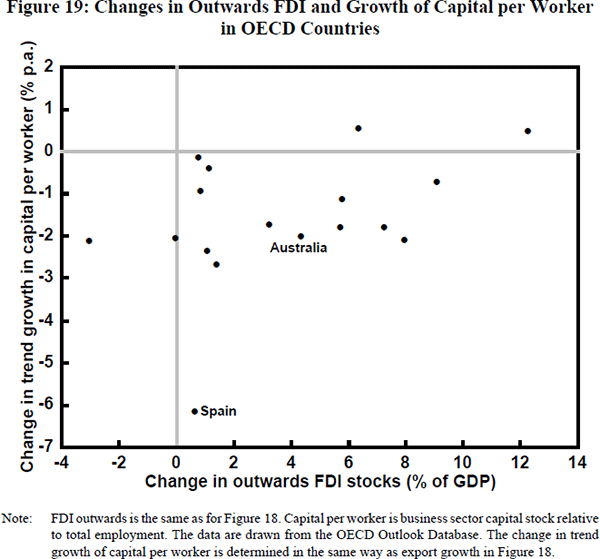
Fourth, increases in the capital stock are not necessarily ‘good’ per se. It is rates of return that matter. Feldstein (1994b) found that, although outwards FDI reduces domestic investment, it is welfare enhancing for US residents as long as the after-tax rate of return on the investment exceeds the after-tax cost of foreign borrowing used to finance the investment. This is based on the assumption that debt capital raised by foreign subsidiaries cannot be imported by the parent company to finance additional investment in the US – that is, it is an additional source of capital that is unavailable to domestic US investors.
Finally, the level of the domestic capital stock is determined by FDI inwards as well as outwards. Australia has always been able to raise sufficient capital to maintain an investment rate well above the OECD average and this continued during, and after, the large increase in outwards FDI in the 1980s. If we have a problem, it is that we have been unable to use our capital stock as efficiently as our competitors – our capital productivity is about 10 per cent lower than the OECD average.[25] The internationalisation of the economy appears to be helping to get the right structure of domestic investment (see Section 3), and it should also help to improve the quality of investment through embedded efficiency improvements. If we get these things right, we will almost certainly get right the amount of aggregate investment.
4.4 FDI Inflows and Domestic Investment
Figure 20 suggests that FDI investors, in aggregate, may be somewhat more sensitive to (or in a better position to react to) changes in the domestic climate than domestic investors. It shows that the relative decline in importance of FDI as a component of private business investment corresponds quite closely with the decline in company profitability seen in the mid 1970s. In other words, the data suggest that the allocation of foreign (or international) saving by multinational companies is more mobile than that of domestic saving. Alternatively, if the new growth theories which ascribe a key role for investment are correct, it is consistent with FDI inwards helping to drive economic growth in Australia.
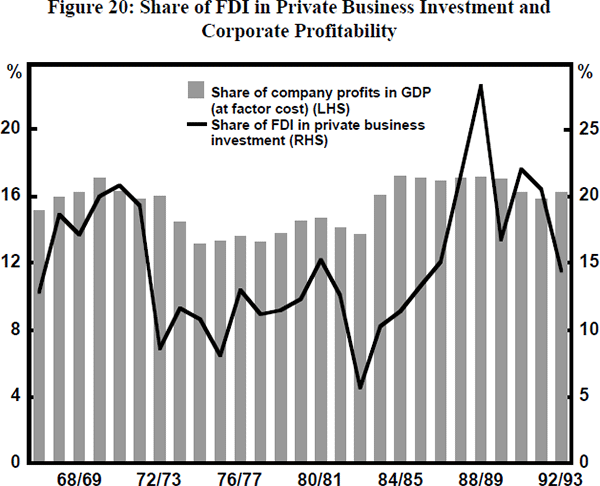
Either way, the data suggest that FDI investors in Australia play an important role in disciplining domestic economic management. This discipline may even go beyond that which multinational enterprises impose on private sector competitors and potential suppliers of goods and services to the MNEs. It adds weight to Kasper's (1992) arguments that the more immobile factors of production, such as government and workers, must create an attractive environment for investment. Moreover, it supports the view that we need to focus our attention on getting the climate for domestic investment right as the best means of attracting international capital. (See BIE (1993a) among many others.)
As is the case in most OECD countries, in the second half of the 1980s much was done to improve the domestic investment climate. That this is bearing fruit for Australia is suggested by recent improvements in perceptions about Australia's competitive position, as monitored by the IMD/World Economic Forum (1993),[26] especially in relation to the government's performance in enhancing competitiveness and progress on internationalisation.
An FDI investor will clearly ascribe different weights to the various factors that determine location, depending on the characteristics of the project. It would be useful from a policy point of view to have a better idea of the relative importance of the contributing factors governing FDI flows in Australia, so that policy may be concentrated in certain areas. But, it needs to be borne in mind that location is determined on a project by project basis. For example, we might conclude that, in general, unit labour costs may receive little weight as a locational determinant for a higher-wage country such as Australia (especially with the abundance of cheaper and productive labour nearby in Asia). However, in the specific case, it may be the critical determinant of the choice between Australia and another similar OECD country. Also, the increased mobility of capital, and embodied technology and management skills, has meant that the costs of policy failure are potentially high.[27]
Finally, the internationalisation of the economy gives cause for optimism that the necessary changes are occurring to allow Australia to reap the full benefit of its resources. FDI plays a central role in this process. The challenge for government is to create the climate to encourage high and profitable investment. Amongst other things this requires: ensuring appropriate taxation arrangements; enhancing the efficiency of economic and social infrastructure; improving the quality of human capital and technological capability; containing production costs; encouraging flexible workplace practices; and ensuring stable economic management. The process of internationalisation increases the benefits of getting these policies right.
Appendix A: Motivations and Locational Determinants of Direct Investment
The decision to invest abroad is generally thought to be motivated by differential returns on investment and the need for portfolio diversification. But, these factors alone fail to explain the distinction between ‘portfolio and other’ investment which does not require control over the host country assets, and FDI investment, which does (IMF 1991; Harris 1994).[28] In a perfect world there is no reason for choosing to exercise this control. The various explanations for the decision to invest directly in another economy have therefore come to rely on market imperfections of one sort or another.
The eclectic framework developed by Dunning (1988) combines three strands of theory on FDI – industrial organisation, internalisation theory, and location theory.[29] It suggests that a firm will engage in FDI only if:
- the firm possesses ownership advantages (e.g. patents, trademarks, management skills, and exclusive access);
- there are market imperfections such that it is more profitable for the firm that possesses ownership advantages to use them itself, rather than to sell or lease them to foreign firms; and
- it is profitable for the firm to utilise its advantages in conjunction with some factor inputs outside its home country.
The first two conditions establish the reasons that a firm may want to invest abroad. The third provides an insight into the issue of why certain locations are chosen over others.
Country advantages as locations for direct investment can take several forms. Table A1 shows the results of a survey of econometric studies of the effects of host and home-country characteristics on locational decisions by firms. Relatively little attention has been given to home-country characteristics to date, although Culem (1988) suggests that home characteristics relative to those in the host country can be influential in some circumstances. The results suggest that important host characteristics include market-based criteria such as the existing industry concentration, sales, population, and GNP. Market size is intuitively important. Taking a firm-specific advantage and succeeding in the US market, even if it were not growing much, would generate much larger profits than taking the same advantage to a rapidly growing Tuvalu (population 10,000). On the other hand, growth prospects are clearly important for assessing future demand.
| Variable | Reference | Effect | Comment |
|---|---|---|---|
| Host country variables: | |||
| Population | Ondrich and Wasylenko (1993) | Positive | State study |
| Land area | Coughlin et al. (1991) | Positive | State study |
| Bartik (1985) | Positive | State study | |
| Per capita income | Woodward and Rolfe (1993) | Positive | Developing countries |
| Coughlin et al. (1991) | Positive | State study | |
| GDP (corrected for openness) | Veugelers (1991) | Positive | Intra-OECD FDI |
| GNP | Culem (1988) | Positive | Inter-industrialised countries. Results vary by sample. US FDI in EC |
| Scaperlanda and Balough (1983) | Positive | US FDI in EC | |
| Lunn (1980) | Positive | ||
| Change in GNP | Culem (1988) | Positive | Inter-industrialised countries. Generally significant but varies with lag |
| Lunn (1980) | Varies | US FDI in EC | |
| Acceleration in GNP | Lunn (1980) | Positive | US FDI in EC |
| GNP growth relative to home | Culem (1988) | Positive | Inter-industrialised countries. Generally significant |
| Predicted sales | Scaperlanda and Balough (1983) | Positive | US FDI in EC. Generally significant |
| Predicted sales growth | Scaperlanda and Balough (1983) | Positive | US FDI in EC. Generally significant |
| Non-tariff barrier | Jeon (1992) | Positive | Developed countries |
| Free trade zone | Woodward and Rolfe (1993) | Positive | Export-oriented investment. Developing countries |
| Trade barrier | Culem (1988) | Positive | Inter-industrialised countries. Results vary by sample. US FDI in EC. Generally significant |
| Scaperlanda and Balough (1983) | Positive | US FDI in EC | |
| Lunn (1980) | Negative | ||
| Interest rate relative to rest of world | Culem (1988) | Positive | Inter-industrialised countries. Often significant |
| Corporate and personal tax | Luger and Shetty (1985) | Negative | Results vary by industry. State study |
| Corporate tax | Ondrich and Wasylenko (1993) | Negative | State study |
| Bartik (1985) | Negative | State study | |
| Tax holiday length | Woodward and Rolfe (1993) | Positive | Developing countries |
| Restrictions on profit repatriation | Woodward and Rolfe (1993) | Negative | Developing countries |
| Transport infrastructure | Coughlin et al. (1991) | Positive | State study |
| Expenditure on higher education | Ondrich and Wasylenko (1993) | Positive | State study |
| Promotional expenditure to attract MNEs | Coughlin et al. (1991) | Positive | State study |
| Effort index | Luger and Shetty (1985) | Positive | State study |
| Political stability (rating) | Woodward and Rolfe (1993) | Positive | Developing countries |
| Exchange rate devaluation | Woodward and Rolfe (1993) | Positive | Developing countries |
| Inflation rate | Woodward and Rolfe (1993) | Negative | Developing countries |
| Jurisdiction deficit | Ondrich and Wasylenko (1993) | Negative | State study |
| User charges | Ondrich and Wasylenko (1993) | Negative | State study |
| Manufacturing concentration | Ondrich and Wasylenko (1993) | Positive | State study |
| Woodward and Rolfe (1993) | Positive | Developing countries | |
| Coughlin et al. (1991) | Positive | State study | |
| Bartik (1985) | Positive | State study | |
| Luger and Shetty (1985) | Positive | State study | |
| Carlton (1983) | Positive | State study | |
| Wage rate | Woodward and Rolfe (1993) | Negative | Developing countries |
| Coughlin et al. (1991) | Negative | State study | |
| Bartik (1985) | Negative | State study | |
| Luger and Shetty (1985) | Negative | State study | |
| Unit labour cost | Culem (1988) | Negative | Inter-industrialised countries |
| ULC relative to home country | Culem (1988) | Varies | |
| Technological capability | Neven and Siotis (1993) | Positive | Manufacturing FDI in EC |
| Labour skill (White-collar proportion) (Number of engineers) |
Luger and Shetty (1985) | Positive | One of three industries. State study |
| Carlton (1983) | Positive | One of three industries. State study | |
| Workers' compensation insurance rate | Bartik (1985) | Positive | State study |
| Unionisation rate | Coughlin et al. (1991) | Positive | State study |
| Bartik (1985) | Negative | State study | |
| Unemployment rate | Coughlin et al. (1991) | Positive | State study |
| Ratio of actual rate to average over several years | Carlton (1983) | Positive | Results vary by industry. State study |
| Transport costs as proportion of export value | Woodward and Rolfe (1993) | Negative | Developing countries |
| Energy prices | Carlton (1983) | Negative | State study |
| Investment to GDP | Veugelers (1991) | Negative | Intra-OECD FDI |
| Same language | Veugelers (1991) | Positive | Intra-OECD FDI |
| Neighbour | Veugelers (1991) | Positive | Intra-OECD FDI |
| Neighbour x size | Veugelers (1991) | Positive | Intra-OECD FDI |
| Capital export control | Scaperlanda and Balough (1983) | Varies | US FDI in EC |
| Growth rate of home economy (lagged) | Jeon (1992) | Positive | Developed countries |
| Jeon (1992) | Negative | Developing countries | |
| Wages in home economy | Jeon (1992) | Positive | Developing countries |
| Exports from home to host country, relative to home GNP (lagged) | Culem (1988) | Varies | Inter-industrialised countries. Generally significant and positive |
|
Source: Harris (1994). |
|||
The more policy-based variables capable of influencing the locational decisions of multinationals include trade-related measures (depending on the orientation of the investments), tax-related measures, transport infrastructure, and economic management. Skill levels, technological capability, and unit input costs are also shown to be key determinants of location.
Another approach, that may have some application in Australia, is the process-oriented model of Johanson and Vahlne (1977) which suggests that initially companies focus on culturally close markets as potential locations, but more distant markets are considered as companies gain more experience (Yetton et al. 1991). Proximity and having the same language relative to the home country are also important according to Veugelers (1991).
The information in the following table is drawn from a background paper by Harris (1994) which presents results from a survey of econometric studies (in some cases using data drawn from companies and in others using aggregate statistics), of the effects of host and home-country characteristics on locational decisions by firms.
Appendix B: The Structure of Private External Borrowing
The increasing importance of inwards FDI for Australia over the past few years reflects a gradual return to the average contribution of inwards FDI to the gross financing requirement of the non-official sector applying in the late 1960s and early 1970s (Figure B1). Some of the apparent relative decline in FDI flows inwards in the 1980s may, however, be illusory.
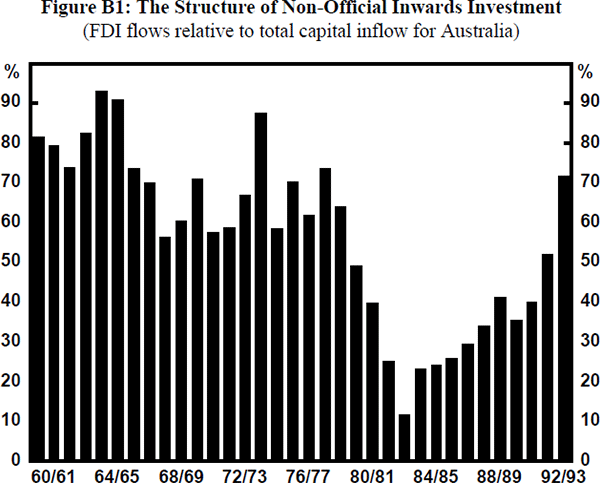
First, the blurring of distinctions between FDI and portfolio and other capital investment due to innovations in financial intermediation makes it difficult to be too precise about the structure of corporate finance in the 1980s.
Second, some part of the debt classed as portfolio and other investment in Australia should properly be ascribed to FDI. The reason for this is that FDI flows can be in the form of equity or borrowing. Any offshore borrowing that is attached to foreign equity should, in principle, be allocated to FDI flows. Data from the ABS suggest that borrowing overseas by foreign companies has historically been very low relative to equity inflows, suggesting that FDI investors gear up using debt raised locally (see Figure B2). However, this may have changed following the liberalisation of capital markets in the early 1980s.
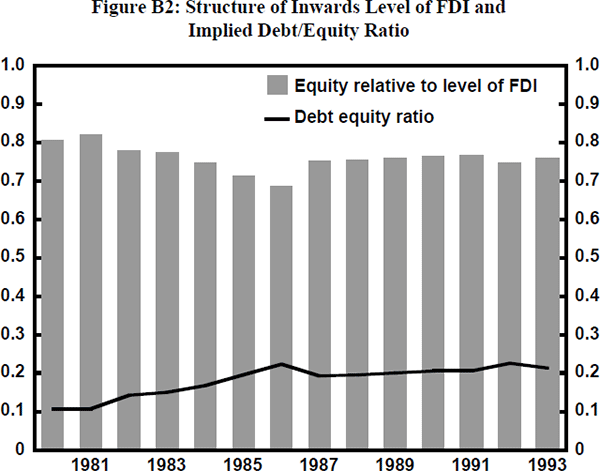
It is not unreasonable to expect that FDI investors increased their borrowing and debt/equity ratios along the same lines, or even more so, than domestic investors following financial liberalisation in the early 1980s. This, however, is not reflected in Figure B2 which shows that direct foreign borrowing levels relative to equity remained low. It is likely, therefore, that FDI investors geared up in the 1980s using some of the debt raised offshore by domestic banks – which is classified as portfolio and other investment but is tied to FDI liabilities.
Footnotes
Direct investment refers to financial investments by a non-resident that allows the non-resident significant direct influence over policy decisions of the enterprise. Until 30 June 1985, the Australian Bureau of Statistics (ABS) used a minimum ownership level of 25 per cent of the ordinary shares of voting stock (or equivalent equity interest) for investment to be classified as direct. Since 1985 the minimum ownership level has been 10 per cent, in line with international practice. The Bureau of Industry Economics (BIE) notes that the change appears to have had little effect on trends in the data (BIE 1993a). [1]
Not surprisingly, these changes in inward OECD stocks of capital were matched by changes in outward stocks of FDI and total assets since the OECD comprises the vast bulk of the world capital market. Much of the data reflect intra-OECD investments. [2]
However, this may partly reflect difficulties in estimation of FDI flows under more liberal capital markets (see Appendix B). [3]
Japan increased outwards FDI at over 60 per cent per annum between 1985 and 1989 (UNCTC 1991). Germany (FRG) also increased its outwards FDI rapidly over the period and was exposed to influences similar to those of Japan. [4]
Consider, for example, technological advances in fields such as large passenger aircraft, microprocessors, telecommunications switching stations, satellites and pharmaceuticals. [5]
With respect to traded sectors this would mean adding value to commodities, and creating potential for niche markets for more elaborately transformed manufactures and certain service industries. For non-traded areas it means reducing costs or increasing productivity. Non-traded areas are, however, not focussed on here. [6]
See OECD (1991, 1992a), BIE (1993a) and EAAU (1994), for a more detailed discussion. [7]
There are no data available on manufacturing trade classified by ASIC industry before the early 1980s. The FDI data for the manufacturing sector are only reported at the 2-digit ASIC level for manufacturing industries used in this paper. It is, therefore, impossible to obtain a match-up of FDI and trade data prior to the early 1980s. Moreover, in recent years, there are significant gaps in FDI data at the 2-digit ASIC level, due mainly to confidentiality problems. [8]
The manufacturing sector here is defined on the Australian Standard Industrial Classification (ASIC) basis. It includes very early-stage processing of agricultural and mining products such as wool scouring and minerals processing. [9]
Such measures are, however, imperfect because industries are not internally homogeneous with respect to factors of production, marketing, or the general business climate. Nevertheless, they do provide a general guide as to which industries are most competitive in world markets. [10]
The Wood and Wood Products industry has a high degree of intra-industry trade, but this characteristic is dominated by the low amount of trade in this industry, hence its allocation to the ‘low-trade’ group. [11]
The choice of 1988 as the year for assessing the change in FDI orientation reflects the lack of a complete set of FDI data by manufacturing sector beyond that year. However, 1988 has the advantage of coinciding with the very rapid growth of FDI flows in the second half of the 1980s, and it avoids the effects of the recession at the end of the decade. [12]
It is worth noting that the industries more likely to invest offshore in 1982, (i.e. had a ratio of FDI assets to liabilities greater than the ratio for all manufacturing of 25 per cent) were the relatively low-traded Fabricated Metals and Non-Metallic Minerals industries. The rationale for low-traded industries to invest offshore is market driven, as described in Appendix A. [13]
The shift offshore by the Paper and Paper Products industry may have been partly motivated by a limited domestic market, and diminishing investment opportunities because of heightened environmental concerns in Australia. Also, the Textiles industry may have seen a reversal recently with inwards FDI in wool processing (BIE 1994). [14]
These factors were found to be especially significant for 25 manufacturing investors in the UK surveyed by Edwards (1994). [15]
See, for example, the article entitled ‘Manufacturing Lures Japanese Investment’ in the Australian Financial Review, 5 July 1994. Data in this article were drawn from the Australia-Japan Economic Institute. [16]
Many of these industries receive export assistance, be it explicitly or implicitly. However, the impact of these programs on export growth from these industries is unclear, although in some cases it is believed to be significant (see IC (1993)). Of course, the ultimate test of the viability of these industries will be when this assistance is removed. [17]
The AMC/McKinsey study found that many low-trade firms are competing successfully in areas such as product design, customer service, and timeliness, thereby overcoming the disadvantage posed by high unit labour costs and the distances between Australia and its export markets. Although encouraging, it should be noted that these firms remain the exception rather than the rule. They do, however, indicate that potential exists for Australian manufacturing to develop world-competitive firms in niche markets. [18]
These sentiments appear to be more prevalent in the US where residents may have been surprised by the influx of FDI into that country in recent years (Graham and Krugman 1989). But with the strong flow of FDI into Australia recently, these issues may resurface. For an Australian perspective see Jones (1992). [19]
Such concerns explain the restrictions placed on outwards FDI in Australia until the 1980s. See BIE (1984). [20]
For example, domestic investors could shepherd domestic labour into low-value-added activities if the investment is aimed at extracting rents through the exploitation of market power. The rents may be retained in the domestic economy but that is unlikely to help with obtaining the best industry or trading structure. [21]
See Graham and Krugman (1989), Forsyth (1990) and EPAC (1993) for an Australian perspective on this. [22]
In other words, outwards FDI shifts domestic saving offshore and domestic investors cannot access foreign saving to finance the implied increase in domestic investment opportunities. The importance of domestic saving for capital stock expansion is underlined by the widely held view that high rates of domestic saving have been an important factor in strong growth in the developing Asian economies. But capital markets are still regulated in these countries. For example, many of these countries have discouraged FDI as a source of capital, and high domestic saving may have been a more important source of finance for them than is the case in the developed countries. Also, World Bank (1993) found that per capita GDP growth was more likely to be leading to high rates of saving in the rapidly growing East Asian economies rather than the other way around. [23]
Trend growth in capital per worker (capital deepening) declined in most OECD countries in the 1980s as the general increases in real unit labour costs in the 1970s were unwound. [24]
It has been argued that this may be due to relative prices in Australia favouring less productive dwelling investments, compared with equipment (Dowrick 1994). Whitelaw (1994), however, argues that relatively high prices of equipment in Australia is a byproduct of lower efficiency growth. [25]
Especially in relation to the executive opinion survey contained in that report. [26]
In this sense, the process of globalisation has probably increased competition among governments in providing a suitable economic climate for investment. [27]
In fact, differential returns and portfolio diversification are regarded as satisfactory explanations for ‘portfolio and other’ investment. [28]
Other theories, such as the product cycle and strength of currency, are regarded as unsatisfactory in some crucial areas (IMF 1991). [29]
References
Access Economics (1994), Australia in Asia, A Monthly Australian Corporate Brief on Economic and Financial Developments March 1994, Access Economics Pty Ltd, Canberra.
Bartik, T.J. (1985), ‘Business Location Decisions in the United States: Estimates of the Effects of Unionization, Taxes and Other Characteristics of States’, Journal of Business and Economic Statistics, 3(1), pp. 14–22.
Blomstrom, M. and A. Kokka (1994), ‘Home Country Effects of Direct Foreign Investment: Evidence from Sweden’, NBER Working Paper No. 4639.
Bullock, M., S. Grenville and A. Pease (1992), ‘Capital Inflows’, The Regulation of Capital Inflow: Office of EPAC Seminar, Background Paper No. 17, AGPS, Canberra, pp. 2.1–2.31.
Bureau of Industry Economics (1984), ‘Australian Direct Investment Abroad: Effects on the Australian Economy’, Research Report No.14, AGPS, Canberra.
Bureau of Industry Economics (1993a), ‘Multinationals and Governments Issues and Implications for Australia’, Research Report No. 49, AGPS, Canberra.
Bureau of Industry Economics (1993b), Australian Industry Trends, May (18), AGPS, Canberra.
Bureau of Industry Economics (1993c), Australian Industry Trends, October (19), AGPS, Canberra.
Bureau of Industry Economics (1994), Australian Industry Trends, April (20), AGPS, Canberra.
Carlton, D.W. (1983), ‘The Location and Employment Choices of New Firms: An Econometric Model with Discrete and Continuous Endogenous Variables’, Review of Economics and Statistics, 65(3), pp. 440–449.
Carmichael, J. (1992), ‘Capital Inflow and Macroeconomic Stability Under Australia's Floating Exchange System’, The Regulation of Capital Inflow: Office of EPAC Seminar, Background Paper No. 17, AGPS, Canberra, pp. 4.1–4.10.
Coughlin, C.C., J.V. Terza and V. Arromdee (1991), ‘State Characteristics and the Location of Foreign Direct Investment within the United States’, Review of Economics and Statistics, 73(4), pp. 675–683.
Culem, C.G. (1988), ‘The Locational Determinants of Direct Investments Among Industrialised Countries’, European Economic Review, 32(4), pp. 885–904.
Dowrick, S. (1994), ‘Impact of Investment on Growth: Externalities and Increasing Returns?’, Investment for Growth, EPAC Background Paper No. 39, AGPS, Canberra.
Drysdale, P. (1993), ‘Japanese Direct Foreign Investment in Comparative Perspective’, Pacific Economic Papers No. 223, Australia-Japan Research Centre, Canberra.
Dunning, J.H. (1988), ‘The Eclectic Paradigm of International Production: A Restatement and Some Possible Extensions’, Journal of International Business Studies, 19(1), pp. 1–31.
East Asia Analytical Unit (1994), Changing Tack, Australian Investment in South-East Asia, AGPS, Canberra.
Edwards, R. (1994), ‘Australia's Foreign Direct Investment: Does it Cause Unemployment?’, Labour Economics and Productivity, 6(1), pp. 13–26.
EPAC (1988), Raw Materials Processing: Its Contribution to Structural Adjustment, AGPS, Canberra.
EPAC (1992), The Regulation of Capital Inflow: Office of EPAC Seminar, Background Paper No. 17, AGPS, Canberra.
EPAC (1993), Medium Term Review: Opportunities for Growth, AGPS, Canberra.
Feldstein, M. (1994a), ‘The Effects of Outbound Foreign Direct Investment on the Domestic Capital Stock’, NBER Working Paper No. 4668.
Feldstein, M. (1994b), ‘Taxes, Leverage and the National Return on Outbound Foreign Direct Investment’, NBER Working Paper No. 4689.
FitzGerald, V.W. (1993), National Saving, A Report to the Treasurer, AGPS, Canberra.
Forsyth, P. (1990), ‘Competitiveness, Microreform and the Current Account Deficit’, Centre for Economic Policy Research, Discussion Paper No. 228, The Australian National University.
Froot, K. (ed.) (1991), Foreign Direct Investment, The University of Chicago Press, Chicago and London.
Graham, E. and P. Krugman (1989), Foreign Direct Investment in the United States, Institute for International Economics, Washington, DC.
Harris, C. (1994), ‘Outward Investment by Australian Companies: Modelling Factors which Influence Locational Choice’, BIE Background Paper No. 2.
IMD/World Economic Forum (1993), World Competitiveness Report.
Industries Assistance Commission (IAC) (1985), Annual Report 1984–85, AGPS, Canberra.
Industry Commission (IC) (1993), Annual Report 1992–93, AGPS, Canberra.
International Monetary Fund (1991), ‘Determinants and Systematic Consequences of International Capital Flows: A Study’, Occasional Paper No. 77, Research Department of the International Monetary Fund, Washington, DC.
Jeon, Y. (1992), ‘The Determinants of Korean Direct Investment in Manufacturing Industries’, Weltwirtschaftliches Archiv, 128(3), pp. 527–542.
Johanson, J. and J. Vahlne (1977), ‘The Internationalization Process of the Firm: A Model of Knowledge Development and Increasing Foreign Market Commitments’, Journal of International Business Studies, 8(1), pp. 23–32.
Jones, E. (1992), ‘Direct Foreign Investment into Australia: Maximising the Benefits’, The Regulation of Capital Inflow: Office of EPAC Seminar, Background Paper No. 17, AGPS, Canberra, pp. 9.1–9.14.
Kasper, W. (1992), ‘How to Maximise the Benefits of Direct Foreign Investment’, The Regulation of Capital Inflow: Office of EPAC Seminar, Background Paper No. 17, AGPS, Canberra, pp. 8.1–8.17.
Kearney, C. (1992), ‘Capital Flows and Macroeconomic Equilibrium with Floating Exchange Rates’, The Regulation of Capital Inflow: Office of EPAC Seminar, Background Paper No. 17, AGPS, Canberra, pp. 3.1–3.15.
Lipsey, R. (1994), ‘Outward Direct Investment and the U.S. Economy’, NBER Working Paper No. 4691.
Lipsey, R. and M. Weiss (1981), Foreign Production and Exports in Manufacturing Industries, Review of Economics and Statistics, LXIII(4), pp. 488–494.
Luger, M.I. and S. Shetty (1985), ‘Determinants of Foreign Plant Start-Ups in the United States: Lessons for Policymakers in the Southeast’, Vanderbilt Journal of Transnational Law, 18(2), pp. 223–245.
Lunn, J. (1980), ‘Determinants of U.S. Direct Investment in the EEC: Further Evidence’, European Economic Review, 13(1), pp. 93–101.
Markusen, J. (1983), ‘Factor Movements and Commodity Trade as Complements’, Journal of International Economics, 14(3/4), pp. 341–356.
McKinsey and Co. (1993), Emerging Exporters: Australia's High Value-Added Manufacturing Exporters, Report for the Australian Manufacturing Council, June.
MITI (1992), Vision for the Economy of the Asia-Pacific Region in the Year 2000, and Tasks Ahead, Report to the EPEC Ad Hoc Economic Group Meeting, August, Tokyo.
Neven, D. and G. Siotis (1993), ‘Foreign Direct Investment in the European Community: Some Policy Issues’, Oxford Review of Economic Policy, 9(2), pp. 72–93.
OECD (1991), The Interrelationship of Trade and Foreign Direct Investment, Working Party of the Trade Committee.
OECD (1992a), ‘Foreign Direct Investment: Trends and Policies’, The OECD Observer, 176, pp. 9–13.
OECD (1992b), Long-Term Prospects for The World Economy, OECD, Paris.
OECD (1993), Manufacturing Performance: A Scoreboard of Indicators for OECD Countries, OECD, Paris.
Ondrich, J. and M. Wasylencko (1993), ‘Foreign Direct Investment in the United States: Issues, Magnitudes, and Location Choice of New Manufacturing Plants’, W.E. Upjohn Institute for Employment Research, Kalamazoo, Michigan.
Rider, M. (1994), ‘External Assets and Liabilities of OECD and Developing Countries’, Reserve Bank of Australia, mimeo.
Scaperlanda, A. and R.S. Balough (1983), ‘Determinants of US Direct Investment in the EEC: Revisited’, European Economic Review, 21(3), pp. 381–390.
Schubert, J. (1992), ‘Portfolio Capital Flows and Macro-Economic Stability’, The Regulation of Capital Inflow: Office of EPAC Seminar, Background Paper No. 17, AGPS, Canberra, pp. 5.1–5.7.
Sinn, S. (1990), Net External Asset Positions of 145 Countries: Estimation and Interpretation, Institut fuer Weltwirtschaft an der Universitaet Kiel, J.C.B. Mohr (Paul Siebeck) Tuebingen, Germany.
Textiles Clothing and Footwear Development Authority (TCFDA) (1993), Annual Report 1992–93.
Thomsen, S. and P. Nicolaides (1991), The Evolution of Japanese Investment in Europe, Harvester Wheatsheaf, New York.
UNCTAD (1993), World Investment Report: Transnational Corporations and Integrated International Production, United Nations, New York.
UNCTC (1991), Government Policies and Foreign Direct Investment, United Nations, New York.
Veugelers, R. (1991), ‘Locational Determinants and Ranking of Host Countries: An Empirical Assessment’, Kyklos, 44(3), pp. 363–382.
Whitelaw, R. and J. Howe (1992), Australia's External Constraint in the 1990s, EPAC Research Paper No. 1, Union Offset Co. Pty Ltd, Canberra.
Whitelaw, R. (1994), ‘Investment and Economic Growth: A Critique of De Long and Summers’, Investment for Growth, EPAC Background Paper No. 39, pp. 39–55.
Woodward, D.P. and R.J. Rolfe (1993), ‘The Location of Export-Oriented Direct Investment in the Caribbean Basin’, Journal of International Business Studies, 24(1), pp. 121–144.
World Bank (1993), The East Asian Miracle, Economic Growth and Public Policy, Oxford University Press, New York.
Yetton, P., J. Davis and P. Swan (1991), Export Myths and Strategic Realities, Report to the Australian Manufacturing Council, AGSM Ltd, Australian Graduate School of Management.